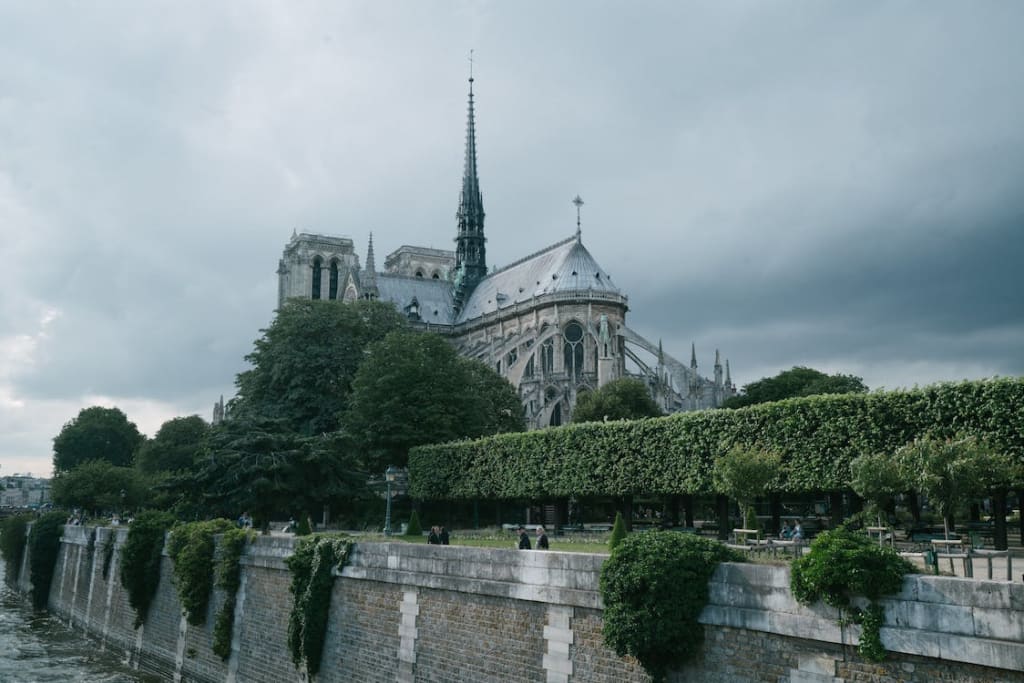Resilience Rising: Rebuilding Notre Dame de Paris
A Testament to History, Art, and Hope

The Notre Dame de Paris Cathedral is located in the northern part of France, in the French capital Paris, at the eastern end of the Île de la Cité, in the historical center. To the north, the cathedral is bordered by Rue du Cloître de Notre Dame and the Hôtel-Dieu hospital. To the east, it faces Square Jean-XXIII and the Fountain of the Virgin, while to the west, it faces Place Jean Paul II, where the statue of Charlemagne and its Landes and the Archaeological Crypt of the Île de la Cité are located.
This architectural masterpiece dates back to the Gothic period. The foundation stone of the cathedral was laid around 1163 by order of Bishop Maurice de Sully, on the site where the Romanesque Basilica of Saint-Étienne stood. Notre Dame went through two main construction phases: the first phase (from 1163 until 1250) included the construction of the choir and ambulatory in 1163, the nave in 1182, the portal of the façade and the two towers around 1190, and the transept in 1225.
The second phase, which began in 1250 and lasted until 1345, involved the enlargement of the transept arms, the construction of chapels, the choir, and the apse, as well as the erection of flying buttresses. The treasury of the cathedral and the sacristy were only built in the 18th century. In 1844, a massive restoration project led by Eugène Viollet-le-Duc took place, during which the spire of the cathedral was rebuilt around 1860. The monument was later listed as a UNESCO World Heritage site in 1991. On April 15, 2019, the church was devastated by a fire. Restoration work is still ongoing, and its reopening is planned for 2024.
With its longitudinal plan in the form of a Latin cross, it covers an area of 6,000 square meters and stretches for 130 meters in length and 48 meters in width. What sets Notre Dame de Paris apart is its transept, which has the same width as the nave and does not protrude compared to the side aisles and chapels. The entrance is through the triple portal framed by the two towers. Then, one enters the narthex with two bays. Afterward, the nave, measuring 60 meters in length, composed of five vessels and ten bays, is reached. There are two series of seven lateral chapels erected between the flying buttresses of the main vessel, opening onto the exterior aisles. The choir consists of five bays topped with sexpartite vaults and is not separated from the nave but rather designed as its extension, although its axis is slightly deviated to the north compared to the nave's axis. It is also surrounded by a double ambulatory and radiating chapels.
As for the elevation, it consists of three levels: the first consists of large arcades opening onto the interior aisles, the second corresponds to a gallery, and the third level is that of the high windows.
Regarding the decoration, it is worth noting that the exterior ornamentation of the building adheres to the Gothic style, with the presence of three remarkable rose windows adorning the north, south, and west facades. These stained glass windows consist of three concentric circles crossed by twenty-four rays, depicting the life of the Virgin and her child. Bas-reliefs depicting biblical characters and scenes, such as the Virgin Mary and the Last Judgment, are also visible primarily on the portals of the western facade. However, the interior decoration is more elaborate in the nave and the lateral chapels. It is worth noting that a collection of paintings entitled "Les Mays" was offered to the church by renowned artists of the time between 1630 and 1707. These pictorial works were displayed on both sides of the nave and in the lateral chapels. The first and most imposing of these paintings depicted the missionary activity of the early disciples of Christ.
Regarding the architectural composition of the facades, the uniqueness of Notre Dame is embodied in its main western facade. It is divided into three symmetrical parts: the first includes a triple portal adorned with sculptures, surmounted by the Gallery of Kings; the second incorporates the large rose window and two ogival windows on either side, while the third consists of a gallery of pillars connecting the two towers framing the facade.
Concerning the construction materials, the cathedral is built with dimension stone extracted from quarries located in the former suburbs of Paris. More precisely, it is composed of Lutetian limestone, which presents two distinct varieties: the "lambourde," a soft limestone used for the interior parts, and a hard limestone reserved for the exterior facades and pillars. Additionally, a fine and hard limestone called "liais" was used for the creation of certain sculptures and columnettes. For the roofing, oak wood was used for the timber framework, covered with lead for the roof and the spire. This framework, nicknamed "La Forêt" (The Forest), consists of numerous beams from different regions of France, notably from the Bercé Forest in Sarthe and the Tronçais Forest in Allier. It was designed to be self-balancing transversely to the axis of the cathedral to prevent the walls from breaking.
As for the construction system, it adheres to Gothic traditions, with the presence of large windows and the soaring height and lightness of the church. It incorporates sexpartite vaults with minimal curvature above the nave and choir, as well as the integration of steel in the construction in the form of clamps connecting the dimension stones. It is worth mentioning a particularity of the flying buttresses of Notre Dame: they consist of a single span and support the upper part of the cathedral's walls. They serve a dual function: firstly, they buttress the facade to prevent its collapse under the weight of the vault, and secondly, they regulate the drainage of rainwater by preventing any seepage on the stone.
In conclusion, the Notre Dame Cathedral in Paris represents an architectural and cultural treasure of immeasurable importance. Its history, remarkable architecture, and iconic status make it a symbol of civilization and French identity. The devastating fire in 2019 was a tragic reminder of the fragility of our heritage and the need to preserve and reconstruct this historic gem.
The reconstruction of Notre Dame de Paris is more than just a material restoration. It is an act of resilience and solidarity, a demonstration of our commitment to safeguarding our cultural heritage for future generations. The global mobilization that followed the fire is a testament to the deep attachment we have to this iconic monument.
Supporting the efforts of restoration and reconstruction of Notre Dame de Paris is essential, whether through financial donations, technical expertise, or awareness-raising actions. Preserving this exceptional heritage will safeguard our history, promote cultural tourism, and strengthen the bond between generations, cultures, and communities.
By rebuilding Notre Dame de Paris, we will send a powerful message to the world: we are determined to protect and transmit our cultural heritage. This reconstruction will be a celebration of history, art, and hope, and a testament to our collective ability to overcome challenges.
Let us preserve Notre Dame de Paris, not only for its architectural beauty but also for what it represents: a timeless symbol of our humanity and our commitment to preserving our cultural heritage.
About the Creator
Karin
The mistery of life isn't a problem to solve, but a reality to experience.
Enjoyed the story? Support the Creator.
Subscribe for free to receive all their stories in your feed. You could also pledge your support or give them a one-off tip, letting them know you appreciate their work.






Comments
There are no comments for this story
Be the first to respond and start the conversation.